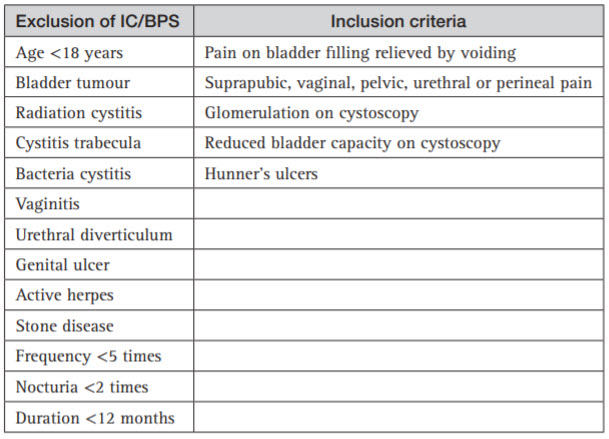Question 8#
Which of the following is an NIDDK criteria for interstitial cystitis?
A. Pain associated with the bladder or urinary frequency of 6 months durationB. Desire to void with the bladder filled to 120 mL of water on cystoscopy
C. Pain associated with the bladder or urinary urgency associated with the presence of glomerulations on cystoscopy visible in at least three quadrants of the bladder
D. The presence of mast cells on histology of bladder mucosa
E. Pain associated with bladder filling and frequency
Correct Answer is C
Comment:
Answer C
Chronic pelvic pain is a spectrum of conditions including urological, gynaecological, musculoskeletal and gastrointestinal pelvic pain syndromes. Urological syndromes comprising pelvic pain syndromes include prostate pain syndrome, bladder pain syndrome (including interstitial cystitis), genital pain syndrome and urethral pain syndrome. Bladder pain syndrome is the preferred nomenclature for syndromes previously known as interstitial cystitis and painful bladder syndrome and this terminology has been adopted by the European Association of Urology and the International Association for the Study of Pain. Interstitial cystitis, described classically as the pathognomonic Hunner’s ulcer and inflammation, is part of the spectrum of bladder pain syndrome.
A consensus criterion for the diagnosis of interstitial cystitis was developed following a series of workshops over 20 years ago. Interstitial cystitis is a symptom complex diagnosed by excluding known causes of symptoms. This NIDDK criteria was intended for use in scientific studies and is shown in table below.
NIDDK diagnostic criteria for BPS/IC:

Further Reading:
Gillenwater JY, Wein AJ. Summary of the national institute of Arthritis, Diabetes, digestive and kidney diseases workshop on interstitial cystitis, national institutes of health, Bethesda, Maryland, August 28–29, 1987. J Urol, 1988; 140: 203–206.